Episode #425: Is Critical Thinking Just a Buzzword in Your Math Action Plans?
LISTEN NOW HERE…
WATCH NOW…
Do you say your math program prioritizes critical thinking, but struggle to see it in action across classrooms?
Many districts include critical thinking as part of their math vision. It is a powerful goal and one that prepares students to engage with complex ideas and make thoughtful decisions. However, teams often lack a shared and practical definition of what critical thinking looks like during math learning.
In this episode, we reflect on a powerful moment from the documentary Counted Out. Students analyze exponential growth and challenge one another’s thinking using real math. That scene led us to consider what conditions allow for this kind of deep student thinking. We also explore how beliefs, systems, and instructional choices can either support or limit the development of critical thinking in math classrooms.
If your school or district is working toward greater coherence in your math instruction, this episode offers a meaningful opportunity to pause, reflect, and consider your next steps.
Listeners will:
- Hear how one real classroom brought math-based critical thinking to life through meaningful dialogue and reflection.
- Learn why unclear definitions of “critical thinking” create misalignment across teams.
- Discover practical starting points — like focusing on metacognition — that help build coherence without overwhelming teachers.
Press play to rethink what critical thinking in math actually means — and why it matters more than ever.
Attention District Math Leaders:
https://files.eric.ed.gov/fulltext/EJ1105157.pdf
Not sure what matters most when designing math improvement plans? Take this assessment and get a free customized report: https://makemathmoments.com/grow/
Ready to design your math improvement plan with guidance, support and using structure? Learn how to follow our 4 stage process. https://growyourmathprogram.com
Looking to supplement your curriculum with problem based lessons and units? Make Math Moments Problem Based Lessons & Units
Be Our Next Podcast Guest!
Join as an Interview Guest or on a Mentoring Moment Call
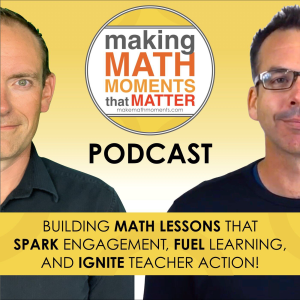
Apply to be a Featured Interview Guest
Book a Mentoring Moment Coaching Call
Are You an Official Math Moment Maker?
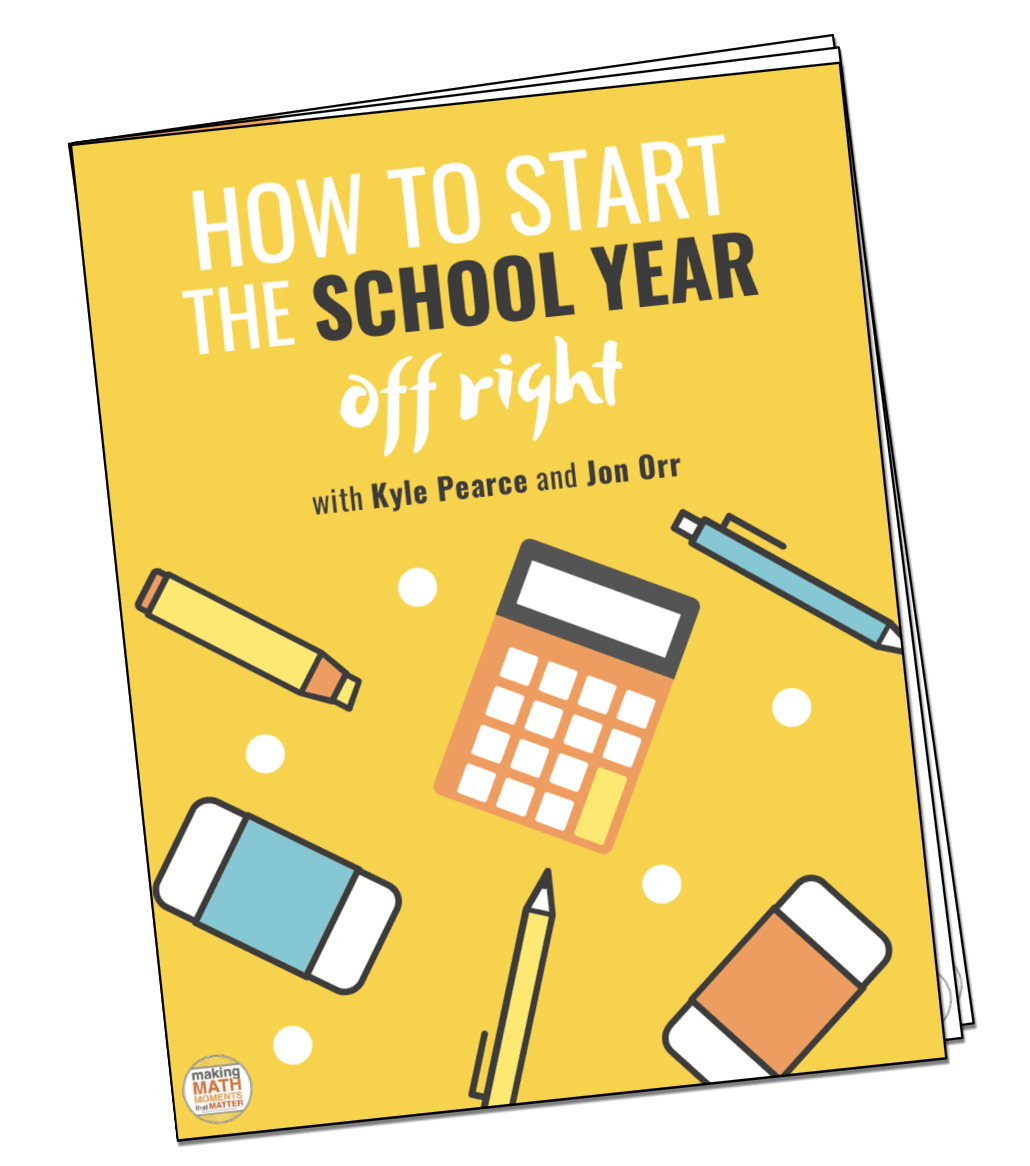
FULL TRANSCRIPT
Kyle Pearce: I think what it comes down to is hopefully encouraging us to ask why more often instead of just accepting what we see or hear. especially when it comes to, data or statistics that are floating around us.
Jon Orr: there are so many important problems we need to solve as a society, in the world, and we’re going to need critical thinkers to do it. And we need different perspectives of critical thinkers to do And currently our school systems aren’t focused on one, designing critical thinkers, but two, getting the different perspectives of critical thinkers. And if we’re going to solve these big world problems, we need to shift our educational system to allow more people in different perspectives, different people, different cultures of people to access more mathematics so that we have more critical thinkers to solve these bigger world
Yvette Lehman: Last week we had a chance to go on a Make Math Moments field trip to the movies. We did. Yeah, that’s right. Our local film festival was screening the movie Count It Out, which had been on our radar for a while and we were excited to have the opportunity to attend. And I left with a big curiosity, I guess I’m gonna say. I’m wondering if yours was the same or I’m sure that there were many things we left walking away pondering.
Jon Orr: Ooh, to be able to watch the movies at 9 a.m.
Kyle Pearce: It was fantastic.
Yvette Lehman: But my big aha or epiphany screening that film was around the idea of critical thinking. I think we use that term a lot in math education. And I left wondering, do I have a deep understanding when I say critical thinking of what I mean? What do other people define critical thinking as? And I thought that the movie did a really great job of showcasing authentic critical thinking. happening in classrooms. So that’s what I wanted to dig into today.
Kyle Pearce: Yeah, you know, I think and we’ve talked about this before about certain terms that come up quite a bit in the math ed space. And I think this is another one where I don’t know how clearly we would be able to or I guess on point, we’d be able to define what it really means. And therefore, if it’s something that we’re trying to emerge more of in our math classrooms, like we certainly want to get all of our heads on. straight or straight ish so that we kind of know what it is that we’re aiming for and what we’re hoping to achieve, right? I think we know what it’s not, right? I think we can identify when critical thinking maybe is absent, but how do we really set that bar at a place where we can truly try to help jump over that bar so that we’re seeing it more often and more consistently across different classrooms in different school systems.
Jon Orr: Yeah, and it’s reminding me of the importance that we talked about in, I think last week’s series of episodes around and making sure that we have a shared of a term that we use on a regular basis, especially one that’s sitting in our vision squirrel move because I saw a message come in and I was like yeah I had no idea what Yvette said because it was like choppy to me. Is it me?
Kyle Pearce: Well, no, but it was, I
Jon Orr: Yeah, this, you know, talking about critical thinking and the definitions, you know, of what this really means is, reminding me of last week’s series of episodes, you know, the, Monday episode, the Thursday episode, where we unpacked the idea of coherence and the importance of having a coherent understanding when we reference terms, especially in our vision statements or our goals or the objectives or the, you know, the zones of improvement that we’re striving it’s, an essential component that if we are going to say, like if we are going to watch the movie, and then we have a takeaway and say I think critical is so important. And right? Are we teaching that in schools? It doesn’t seem like it, you we’re not seeing it in the classrooms, we’re, you know, walking through the movies, obviously making a very important about how critical thinking can actually strengthen our society and how do we structure our school systems to help us do more of that, but what do we really mean when we say critical thinking? It brings us back to the coherence idea.
Yvette Lehman: You mentioned a good point about vision statements. that’s one of the reasons that that idea resonated with me from the film was that so many of the districts that we support have the idea of critical thinking in their vision. And it made me wonder, What do we mean by critical thinking? So I wanted to do some digging. And actually the first place I started, this surprised me, it may not surprise you. I went to the Ontario curriculum because I know that critical thinking is in the Ontario curriculum.
Kyle Pearce: Hmm. Sure.
Yvette Lehman: I assumed though it was under process expectations, but it is not, which is very interesting to me. Do you know where they have critical thinking? Under social emotional, yes. And at first, you know, I thought that critical thinking was more of a process expectation, but then when I started to actually think about what critical thinking is, it makes sense that it’s tied to our social behaviors. and how we engage as members of a society.
Jon Orr: in the, gonna say the new SELs, right.
Yvette Lehman: There’s a pretty in-depth definition of critical thinking and creative thinking in the Ontario curriculum under the social-emotional, but I kind of captured a summary of what it’s essentially saying, which is that critical thinking helps us make informed judgments and decisions. These skills rely on a clear understanding of ideas, situations, and their implications. And it’s like students are essentially learning to… discern information, and then ultimately make wise decisions. That’s how they essentially define it. And I think that one of the big ideas that I took from the movie is that information is all around us constantly we’re inundated with information through the media. And the ability to really in I think one of the presenters spoke about like lifting the hood behind behind the information and not just taking it at face value.
Kyle Pearce: Mm-hmm.
Yvette Lehman: Like being able to recognize that there’s bias or that there’s, you people are intentionally sharing particular data for the purpose of manipulating your opinion on a variety of topics and to position our students to question and to think deeply about the information that they’re receiving constantly in society.
Kyle Pearce: Hmm. Yeah, this is, it’s interesting because it’s like everything in the world around us, there’s, there’s so much going on. And now you can see, especially with AI and you know, all the things that are going on, you can imagine that it’s going to only get more difficult in order to actually wade through what is really happening.
Kyle Pearce: and to be able to actually process what that actually means in order to make wise decisions. I like that idea that, you know, like critical thing is like to help you make wise decisions, you know, and, and that is incredibly challenging. And really, I think what it comes down to is hopefully encouraging us to ask why more often instead of just accepting what we see or hear. especially when it comes to, you know, say data or statistics that are floating around us.
Jon Orr: Yeah, and I think one of because it makes sense, like critical should be in all of our visions in a way, because this is, one of the big pieces of the movie and the documentary is to say like there is, there are so many important problems we need to solve as a in the world, we’re going to need critical thinkers to do And we need different perspectives critical thinkers to do it. And currently our school aren’t focused one, designing critical thinkers, but two, getting the different perspectives of critical thinkers. And if we’re going to solve these big world problems, we need to shift our educational system to allow more people in different perspectives, different people, different cultures of people to access more mathematics so that we have more critical thinkers to solve these bigger world to was the big message that I took away from the movie to say that we’re currently not doing that and we have no hope for the future in a way if we can’t do that and therefore we need a massive call to action to make shifts in our educational system to allow more people through the doors so that we can solve bigger problems in our society. So having critical thinking is important in your mathematical visions. your vision statements and if we don’t have vision statements, we need to make sure that we are including and I’m glad that our teams have that part in that but again, let’s get specific about what does that mean? What are our teams and what are you? If you don’t have a vision, one, you’re gonna make your vision for mathematics but two, if you include critical thinking, what does that mean and what are your next for you and your team to do to actually create the coherence that you need to see your vision come to life?
Yvette Lehman: love the definition if you put it really simply when you say like what is critical thinking? It’s we want students to think carefully, question deeply and decide wisely. That’s kind of a summary of the behaviors that we want from our students. There was a really great clip in the movie. The movie again is counted out where do you remember when the students were talking about the exponential growth of the COVID virus and
Yvette Lehman: I loved how they were sitting and debating and questioning. And at one point they were looking at the growth and their model was projecting over a billion infections. And one student said, well, if the mortality rate is only 2%, should we be concerned? And then they talked about, you know, what is 2 % of a billion and what is the magnitude of that quantity? And now we’re talking about millions of people dying. And the way that the students were interacting in that one clip, I thought was such a powerful example of what we mean by critical thinking.
Kyle Pearce: Yeah. Well, that student who made that 2 % comment, it’s like he backstepped after, right? Which I thought was great, because it’s sort of like he was the one sort of like posing this conjecture that maybe it’s not that big of a deal. And then when they did the math, he’s the one who backed up. And he went, whoa. He’s like, no, that’s actually a big deal. know, like, that’s a lot of people. And, and, of course that didn’t account for what happens when the next stage of the compound, you know, growth actually starts happening or the exponential growth happens. So, you know, when, when we look at this, one thing that I, I hope that our, our teams that are listening and leaders who are listening to this podcast don’t forget is that like, in order for us to be good critical thinkers, we also need to make sure that we understand mathematics. Because if we don’t actually have the number sense, the fluency, these are pieces. Sometimes when we look at the idea of critical thinking or problem solving or doing some of these things in our math class, sometimes we automatically assume that’s the focus and we’re not going to focus so much on automaticity or we’re not going to focus on some of these pieces. When in reality, you really can’t be a solid or you can’t have a high level of critical thinking on your side if you’re unable, if you don’t have that fluency flexibility with numbers. So, you know, it’s not a one before the other either, right? Like it’s like, we wanna actually develop these things together in tandem, right? As we move along, as we’re exploring number, we wanna… utilize critical thinking skills in order to answer important questions along the way. And as both grow, we can move up the complexity ladder so that we’re solving bigger and bigger and more important challenges.
Jon Orr: Mm-hmm. Right, yeah, I don’t think anyone’s gonna argue that it’s not an essential component of learning mathematics or why we’re learning mathematics and one of the reasons we’re learning mathematics. You’ve got, you know, multitudes of research papers, organizations like NCTM recommending that this is an important move to make in the work that we’re trying to do across our systems. The question really is, how do you do it? know, like, how do you align a team? and get more teachers to focus on it. Because if it is part of our vision, if it is sitting there going like our vision for math is including critical thinking, then we now have to step back and go like, is that what we’re doing in our classrooms? And if we’re not, because I think a lot of people, when we talk with know, prospective district partners, every week we meet with people about what they’re doing in math improvement planning, what their PDs are looking like, how do we do these things a little bit better? Most times it’s like, we’re not seeing that in the classrooms And we want to do more of that. And the question usually is, how I move the needle? How do I get more of that?
Yvette Lehman: the question I was asking myself is imagine that scenario that we saw in the movie where the students were sitting around debating, talking, making conjectures, confirming their understanding. What are the conditions that create that opportunity for students? And so I started to dig in to see if there was research out there and I did find one article that I thought was really relevant to this topic which was it was called Mathematical Teaching Strategies Pathway to Critical Thinking and Metacognition.
Yvette Lehman: released in 2016 in the Journal of Research in Education and Sciences. And I was looking for an article or a study that would give me some concrete examples, like concrete moves that teachers can make to support critical thinking in their classroom. And okay, so this is the one, this was one idea that I took away from this particular article, we’ll link the article in the show notes, but it talked about something that we’re not. unfamiliar with, which is replacing the teaching of formulas through mathematical experiences. And basically, they talked about these ideas similar to, know, I could just go ahead and teach the long division formula. I could do that. Or through mathematical experiences, we could reveal the behaviors of division. And for example, you know, sometimes maybe I want to think of division rather than the long division formula as just understanding that as long as I keep the dividend and divisor the same and I scale them both and I create these equivalent ratios, I can just simplify the division and solve it in a different way. And it’s basically their idea. They used multiplication as the catalyst for this exploration, but it’s like rather than going straight to the formula, it’s like, can we have these mathematical experience where we can actually question and ask ourselves, is this always true? And… You know, is it always true that when I’m dividing, can scale both the dividend and the divisor by the same scale factor to simplify the division? Is that true? Can I use this every time? And so they said, they talked about creating experiences like that, where students are making sense of the behavior of the mathematics and questioning. It actually reminded me, and then I’m going to stop talking because I feel like I’m on my soapbox now, but remember, John, when we were solving that area problem recently and we were solving the area of the triangle.
Kyle Pearce: Yeah.
Yvette Lehman: And I said that rather than multiplying the base by the height and dividing by two, I’m just going to half the base and multiply by the height. That is an example of critical thinking because it’s like I’m making decisions that are mathematically sound based on my understanding of the behaviors and the properties.
Jon Orr: Alright. Hmm. Right. And at the time when we unpacked that example, the way that we both, you solved it versus I solved it, I think we were in a way articulating that you were using procedural fluency and you had procedural fluency because you’re like, hey, I know that I can, I got a formula here, I got this procedure, but I know that I have a little bit more fluency that it doesn’t matter what order I do this in. And therefore I can half the bass and then multiply, or I could multiply and then half. And so that, know, is it, cause it brings up like critical thinking is very much intertwined with all the other things that we want for in our students and also with our teachers.
Kyle Pearce: Right, which I think is like, this is exactly why when we advocate for students solving problems using, you know, models and strategies and, and, know, mathematical discourse and like working through problems and that we’re not just following one procedure on how to come to an answer. Like that is how you generate both ends of the spectrum. Like we get better sense of number, fluency, flexibility, automaticity. But then we also get to practice critical thinking all the time. And when we do it on these smaller scales, and I don’t want to discount the fact that some of these problems, they’re not life-changing problems that we’re solving in a math classroom necessarily. But the reality is that when we get kids thinking that way, we get them always optimizing, this idea of constantly optimizing situations so that They can articulate their thinking. They can help others to understand their thinking, right? Communicating that thinking. We can then extrapolate that to other parts of our life. When a problem arises, we’re not going to just stand there and go like, I don’t know how to solve it. Like we actually start to do some critical thinking and thinking, hey, could we go about this idea in a different way so that we can achieve either the same result faster or a better result in whether it’s a longer period of time or not. It’s like we’re able to get to a better conclusion at the end.
Jon Orr: All right, let me recap a little bit of where we are because it’s like, we’ve said critical thinking is essential. We’ve said that many schools, school districts say we want that to be an essential component of the work that’s happening in our classrooms. Yvette has shared the research of why, but also shared some recommendations I think we all understand are important of like what that would look like, which is like teaching through tasks, teaching through experience, doing a lot of behavior. connecting it to ideas that we hold true and those types of things and those types of lesson structures. But there’s still that lingering, I’m a math coach, I’m a math coordinator, what do I really do with that? Because it’s almost like, but I knew this, I knew this, Yvette, we all knew this.
Yvette Lehman: I wonder if a really high leverage place to start and I mean Kyle’s not going to be surprised when I say this because I’ve been advocating this for years based on Hattie’s work is there’s a really close connection between critical thinking and metacognition. The ability to think about your thinking and to reflect on your process. And so that would might be when we think about what’s a first step we could take. You know we’re talking about transformation, we’re talking about shifts in practice.
Yvette Lehman: What if the very first step we took was just making metacognition more ingrained in the fabric of our classrooms through reflection, through student provocations to think about their thinking or explain their thinking or justify their reasoning? Maybe that feels like a more realistic first move. And Hattie, of course, has a lot of research around metacognition and strategies to support metacognition in the classroom. That was one of the big ideas of that article as well, is that these two concepts are very interwoven. Thinking about your thinking is going to support our ability to reflect on our decisions and reflect on our choices and reflect on maybe the bias that existed in the, you know, the conclusions that we drew. I love metacognition. It was a huge shift in my own practice to really take the time to stop and have students think through the decisions that they made. And that goes back to deciding wisely, right? Which was one of our pillars of what how we define critical thinking.
Yvette Lehman: how we define critical thinking.
Jon Orr: Right, yeah. And I’m gonna, the risk of sound like a broken record if you’ve listened to many of our episodes before is that if we wanna see that more in the classrooms, we have to be prepared to help our teachers also make those same practices with their own mathematical thinking and their own experience with mathematics. So we can’t just say we want critical thinking to show up in our classrooms without giving a clear image, a clear puzzle picture. of what that should look like, what that could look like, what are some of the moves that we could be putting into place. And if we’re not, say, every time we have professional development sessions, PLCs, interactions with teachers, we’re not trying to emulate or model what that could look like in the classroom or just with each other, then you’re not, you like, you could say that you want it, but whether it actually translates, it’s because. We have to help everyone understand what we mean. So we cycle back to the coherence. When I say critical thinking, do we understand, do have a common ⁓ definition of what that means across our school system or our schools or our districts? And do we know what that looks like in the classroom? And do we know what the tools help, know, the tools that we have access to to help us do? We have to do that at all fractal levels. We have to do that with our schools. We have to do that with our district PDs. We have to do that with our staff meetings. We have to say, this is an important component. This is what we mean by that, and here’s what it looks like, and here are some pathways to help clear the way.
Yvette Lehman: Thursday this week, we’re going to have, I’m going to be the, you’re going to be coaching me again. I feel like this will be a great episode because I, we do support many districts who are striving for critical thinking. And so on Thursday, we’re going to unpack some recommendations, some concrete examples that we’re going to share with one of our district partners. when they come together as a team and they try to, they’re striving towards this vision that really is grounded in critical thinking for students. So that will be Thursday. We’re gonna unpack some concrete recommendations that we’re gonna bring back to one of our district partners.
Jon Orr: So, don’t forget, set a reminder. When that Thursday episode comes out, make sure that you set it up, queue us up so that you can continue this conversation and keep digging into this topic this week. If you wanna dig in a little further and understand the components of a healthy mathematics program, you can learn the six components of that program over at makemathmoments.com forward slash grow. That’s makemathmoments.com forward slash grow. There’s an assessment there you can fill out and we’ll give you a snapshot of the six areas and the strength of each of those areas for you and your school system. Take care everybody, we’ll see you soon.
Thanks For Listening
- Book a Math Mentoring Moment
- Apply to be a Featured Interview Guest
- Leave a note in the comment section below.
- Share this show on Twitter, or Facebook.
To help out the show:
- Leave an honest review on iTunes. Your ratings and reviews really help and we read each one.
- Subscribe on iTunes, Google Play, and Spotify.
DOWNLOAD THE 3 ACT MATH TASK TIP SHEET SO THEY RUN WITHOUT A HITCH!
Download the 2-page printable 3 Act Math Tip Sheet to ensure that you have the best start to your journey using 3 Act math Tasks to spark curiosity and fuel sense making in your math classroom!
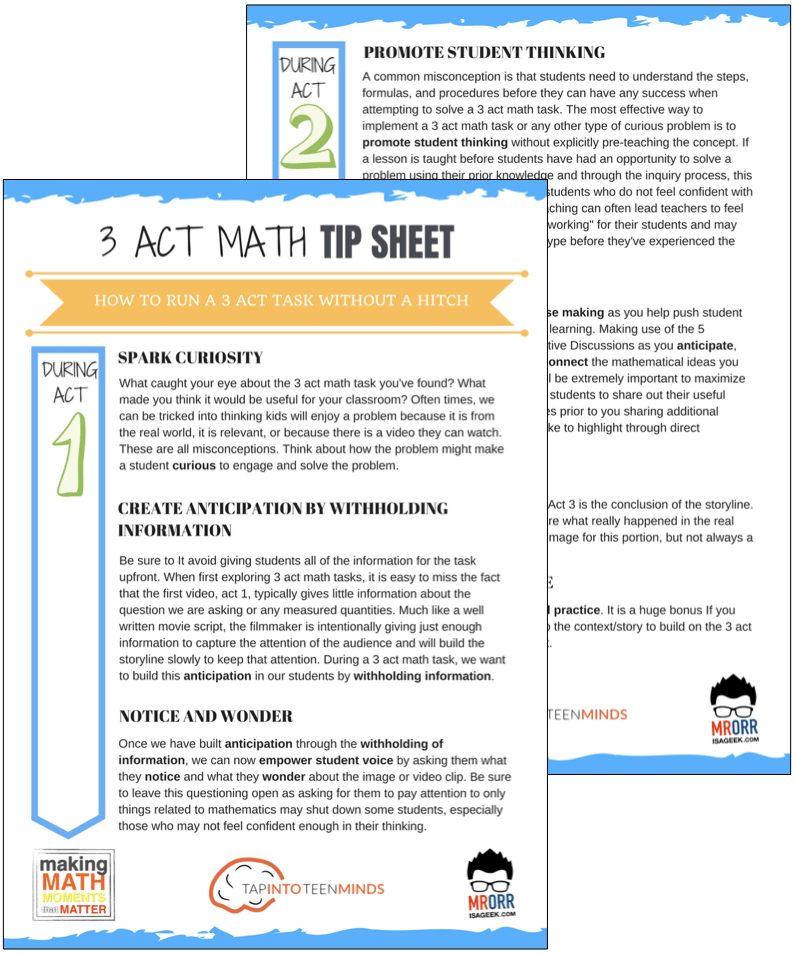
LESSONS TO MAKE MATH MOMENTS
Each lesson consists of:
Each Make Math Moments Problem Based Lesson consists of a Teacher Guide to lead you step-by-step through the planning process to ensure your lesson runs without a hitch!
Each Teacher Guide consists of:
- Intentionality of the lesson;
- A step-by-step walk through of each phase of the lesson;
- Visuals, animations, and videos unpacking big ideas, strategies, and models we intend to emerge during the lesson;
- Sample student approaches to assist in anticipating what your students might do;
- Resources and downloads including Keynote, Powerpoint, Media Files, and Teacher Guide printable PDF; and,
- Much more!
Each Make Math Moments Problem Based Lesson begins with a story, visual, video, or other method to Spark Curiosity through context.
Students will often Notice and Wonder before making an estimate to draw them in and invest in the problem.
After student voice has been heard and acknowledged, we will set students off on a Productive Struggle via a prompt related to the Spark context.
These prompts are given each lesson with the following conditions:
- No calculators are to be used; and,
- Students are to focus on how they can convince their math community that their solution is valid.
Students are left to engage in a productive struggle as the facilitator circulates to observe and engage in conversation as a means of assessing formatively.
The facilitator is instructed through the Teacher Guide on what specific strategies and models could be used to make connections and consolidate the learning from the lesson.
Often times, animations and walk through videos are provided in the Teacher Guide to assist with planning and delivering the consolidation.
A review image, video, or animation is provided as a conclusion to the task from the lesson.
While this might feel like a natural ending to the context students have been exploring, it is just the beginning as we look to leverage this context via extensions and additional lessons to dig deeper.
At the end of each lesson, consolidation prompts and/or extensions are crafted for students to purposefully practice and demonstrate their current understanding.
Facilitators are encouraged to collect these consolidation prompts as a means to engage in the assessment process and inform next moves for instruction.
In multi-day units of study, Math Talks are crafted to help build on the thinking from the previous day and build towards the next step in the developmental progression of the concept(s) we are exploring.
Each Math Talk is constructed as a string of related problems that build with intentionality to emerge specific big ideas, strategies, and mathematical models.
Make Math Moments Problem Based Lessons and Day 1 Teacher Guides are openly available for you to leverage and use with your students without becoming a Make Math Moments Academy Member.
Use our OPEN ACCESS multi-day problem based units!
Make Math Moments Problem Based Lessons and Day 1 Teacher Guides are openly available for you to leverage and use with your students without becoming a Make Math Moments Academy Member.
Partitive Division Resulting in a Fraction
Equivalence and Algebraic Substitution
Represent Categorical Data & Explore Mean
Downloadable resources including blackline masters, handouts, printable Tips Sheets, slide shows, and media files do require a Make Math Moments Academy Membership.
ONLINE WORKSHOP REGISTRATION
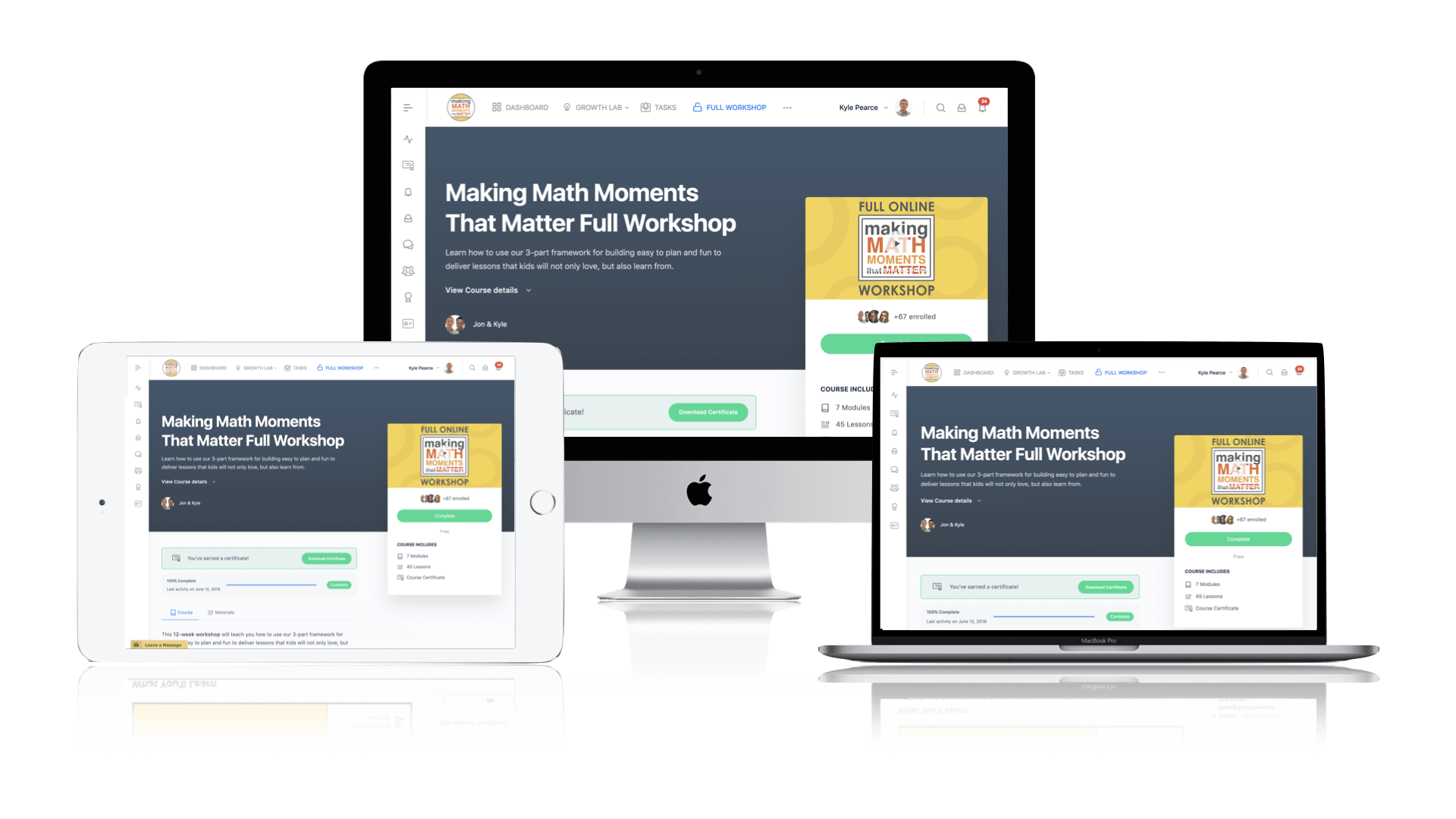
Pedagogically aligned for teachers of K through Grade 12 with content specific examples from Grades 3 through Grade 10.
In our self-paced, 12-week Online Workshop, you'll learn how to craft new and transform your current lessons to Spark Curiosity, Fuel Sense Making, and Ignite Your Teacher Moves to promote resilient problem solvers.
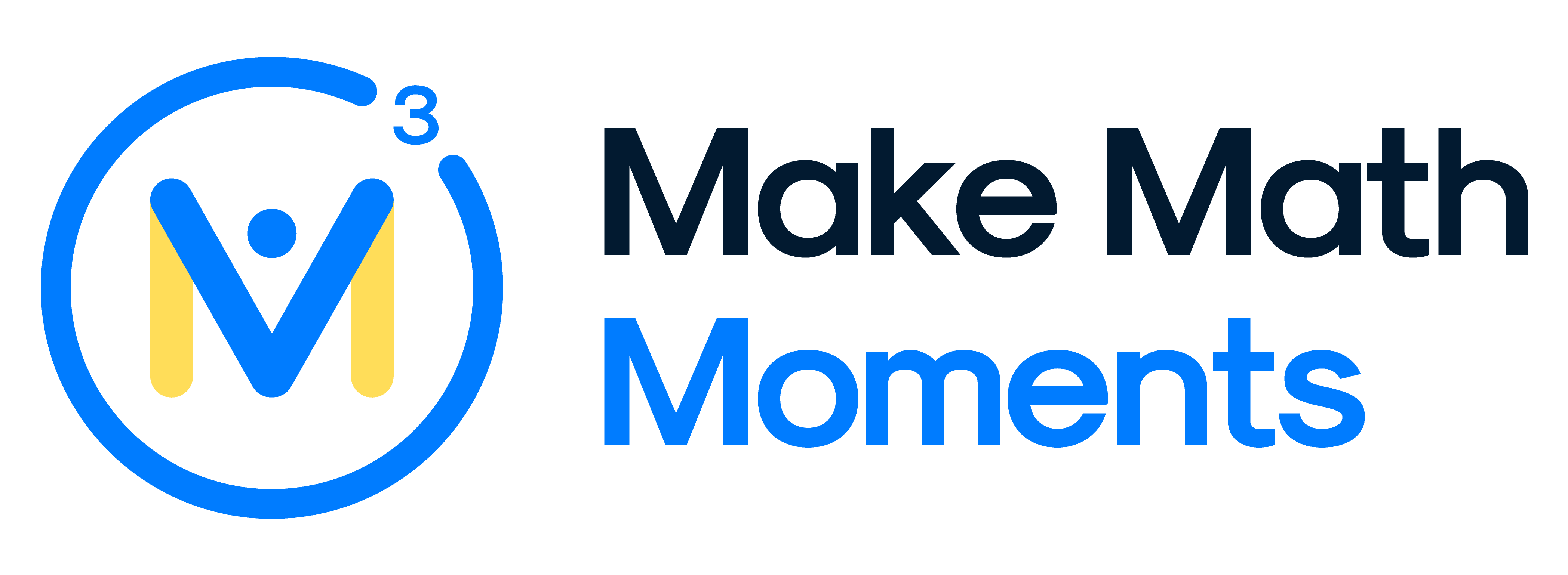



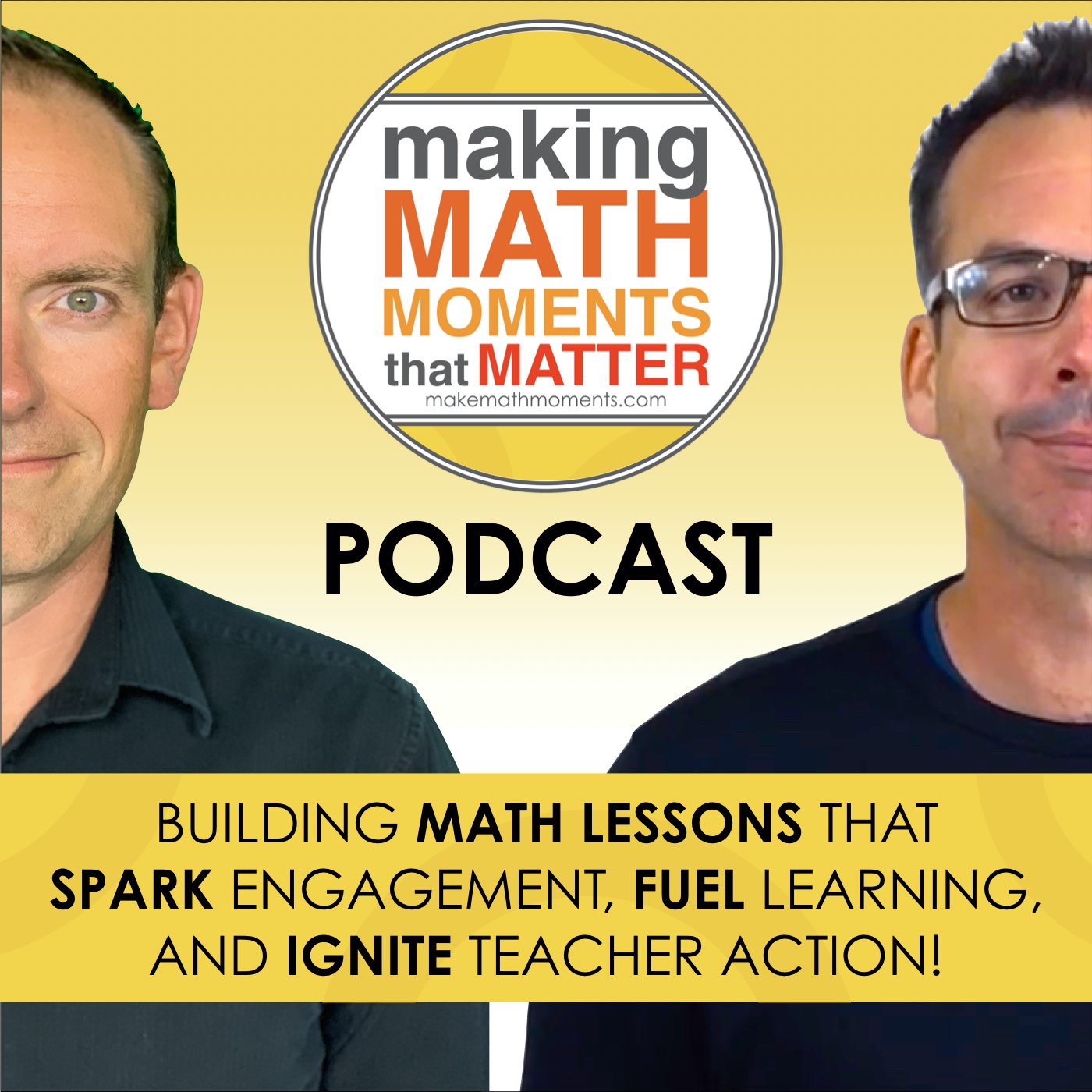

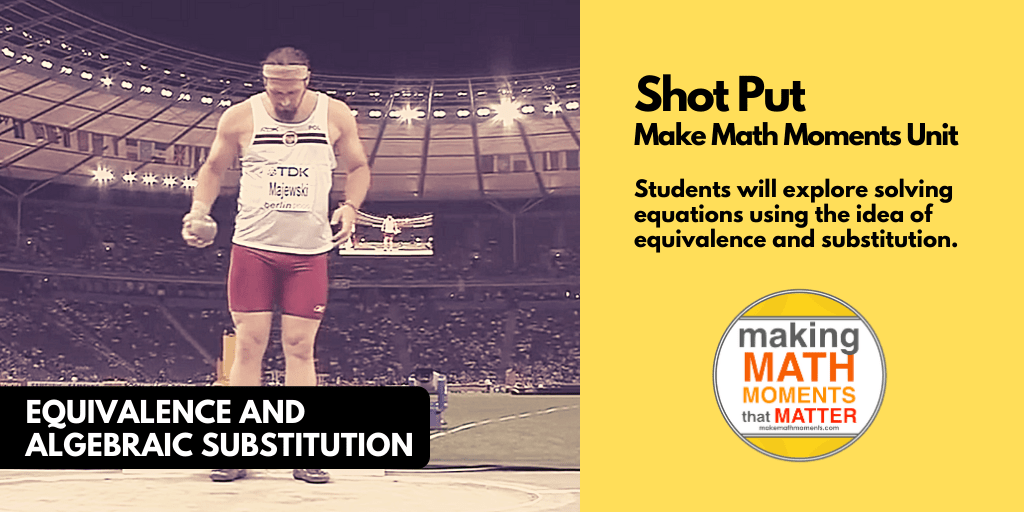
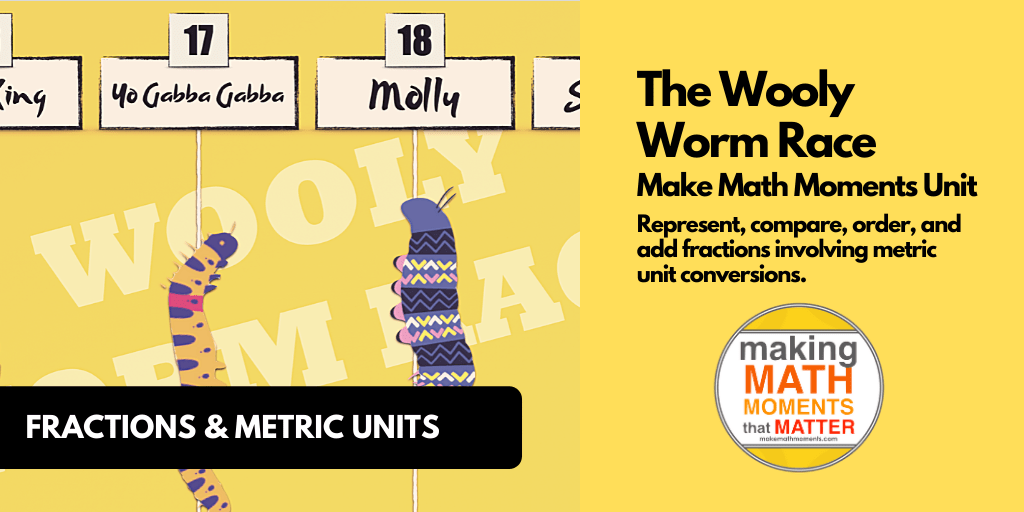
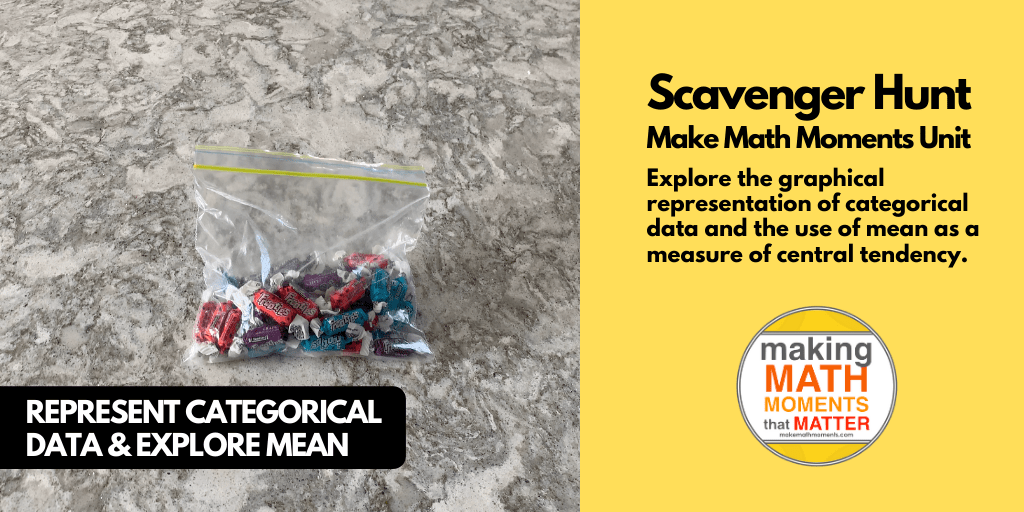

0 Comments